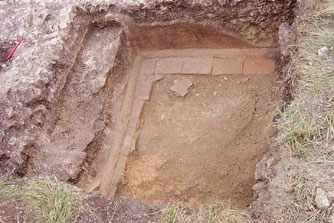Our home from 1988 to 2006
Minchington is an area with extensive archaeological remains and in March 2004 Channel Four's Time Team carried out a dig on Simon Meadon's land. The following article and the photograph are reproduced from the programme's original web pages. The episode can be see here
Brimming with remains
- Archaeological work carried out on this site in the past, by the East Dorset Archaeological Society and Bournemouth University, revealed that farmer Simon Meadon's land at Minchington, Cranborne Chase, is brimming with archaeological remains. Two main areas in particular were found to contain evidence for buildings, enclosures and possibly even burials. For the last time in this series Time Team had just three days to make sense of it all.
Different periods
- A large-scale geophysics survey confirmed that the landscape contained a variety of archaeological features. These turned out to be from a number of different periods. For example, trenches on the hilltop at Goldfields revealed a circular enclosure ditch, which was excavated to reveal a cross section of the ditch fill. Though no dating evidence was found, the shape of the ditch was considered to be Bronze Age.
A second enclosure ditch and associated post holes were excavated that contained pottery indicating an Iron-Age date. Cutting through the ditch feature (indicating that it was a later event) was a grave. This grave was associated with six other grave cuts, three of which were excavated. Grave goods, including a complete dimple sided pot, indicated that they belonged to relatively low status individuals of the third or fourth century AD.
Roman bath house and villa
- Further geophysics surveys indicated structures in the valley bottom at Myncen Farm. Excavations here revealed the site of a Roman building, complete with a hypocaust system, a series of walls and an intact plunge pool complete with painted plaster sides relating to a bath house.

The presence of a bath house indicated that an associated Roman villa complex must be nearby. Phases evident in the wall construction indicated that the building was upgraded in the third or fourth century, the same time as the burial ground was in use over the ridge.
Rebellion and revenge
- Dating evidence from the site appeared to stop in the mid-fourth century AD, although many villas were occupied until the end of the fourth century and sometimes later.
Guy de la Bédoyère speculated that this fact could point to a particular time in history, when Magnentius, a rebel emperor, broke away from Rome.
Magnentius's rebellion, in 353 AD, was quashed and the Roman emperor Constantius II sent his imperial secretary, Paul, to Britain to sort out the situation. Paul was extreme in his revenge and many villas of sympathisers of Magnentius were destroyed. It is possible that this villa could have been destroyed at this time.
Photo by Matthew Reynolds
Life and death in Roman Britain
- The excavations at Minchington could reveal a snapshot of life and death in Roman Britain. The landscape shows a continuity of occupation from earlier prehistoric settlement. By the third or fourth century, the 'gentry' had developed their villa in the valley while the lower classes worked the land and buried their dead over the ridge.
Are the two sites related? They were certainly in use at the same time, so perhaps they were part of the same estate. One thing is certain: farmer Simon Meadon is only the latest in a long line of people who have managed and worked the landscape of Cranborne Chase.